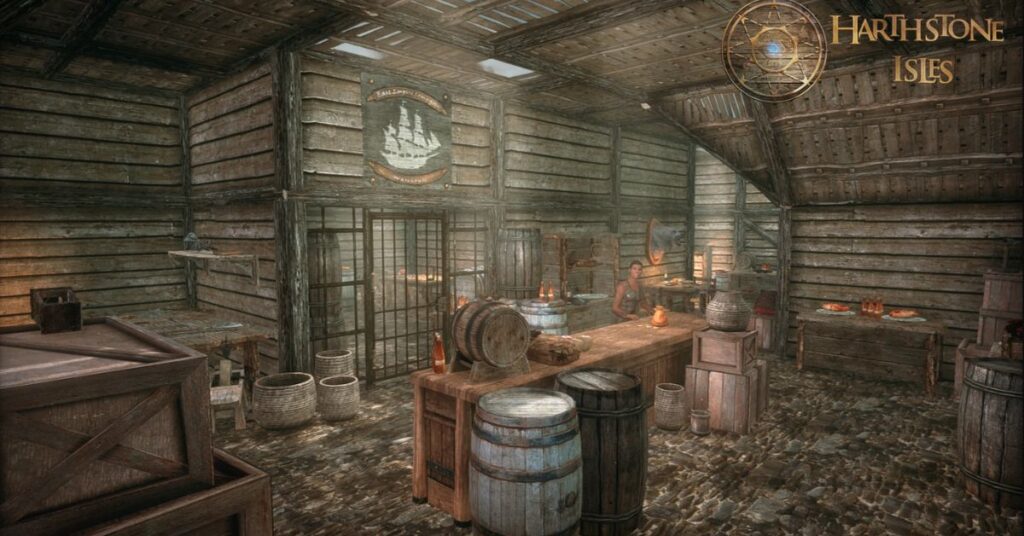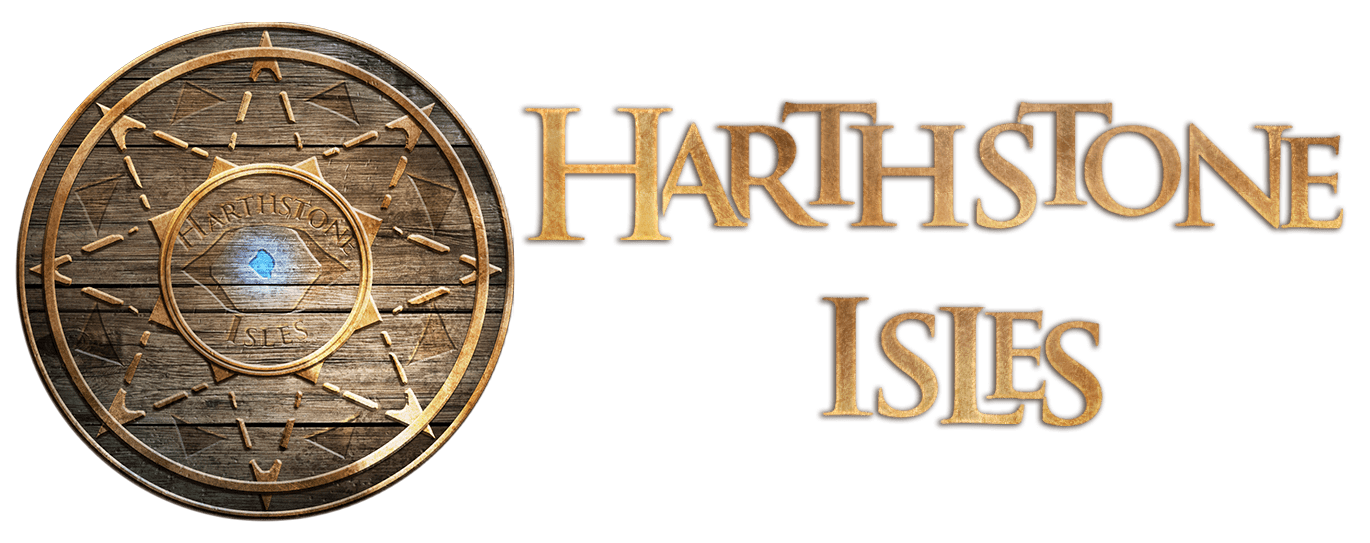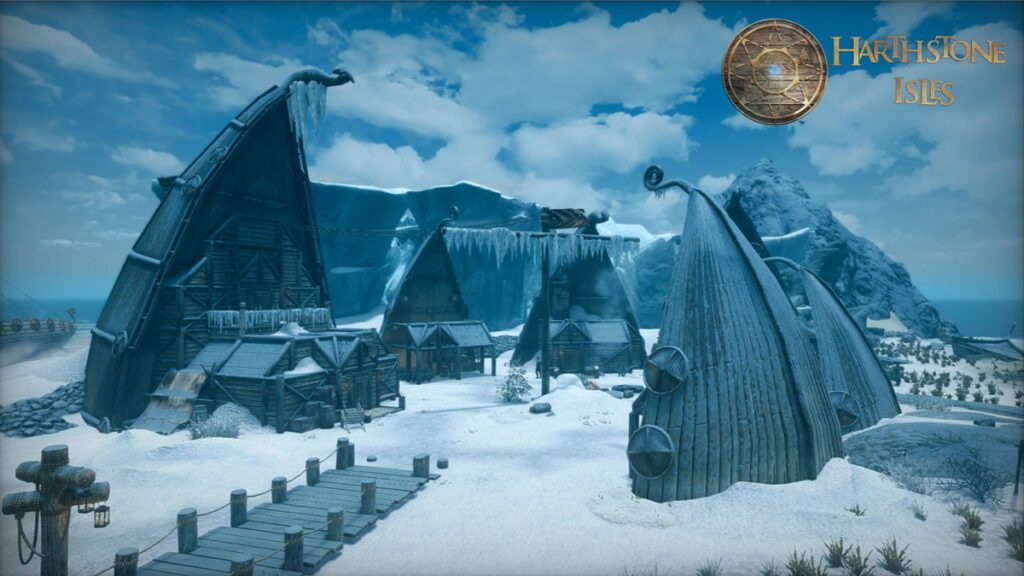
A collaborative mod created for Skyrim Special Edition and released on Nexus Mods. The project strengthened my quest design skills and enabled me to co-create alongside level designers, voice actors and project leads in a team-based virtual environment.
Brief
Harthstone Isles is a short-term collaborative modding project for Skyrim Special Edition that I worked on as part of Beyond Skyrim’s Arcane University. The project began in October 2022 and culminated in the public release of the mod in July 2023. I was part of the writing team, with individual responsibility for creating an NPC, writing their dialogue and designing an associated quest. The Arcane University is made up of students and teachers from across the world, and as an HSI dev, I formed part of a smaller team who worked remotely using Discord, Trello and Google Suite to complete the project over a number of months.
Play Harthstone isles

Creative Process
The process for creating Harthstone Isles was set out clearly from its inception in October. This is the third Arcane University collaborative project that I’ve worked on, after 2022’s release Hestra’s Nest. With a bit of prior experience, I knew that writing work would be the project’s first priority. For my contribution, I followed this workflow.
- Introductory Phase and Research
- The theme of the mod was revealed and department leads were also assigned. Harthstone Isles would be a new archipelago based in Skyrim’s Sea of Ghosts, and it needed a number of new NPCs and quests for players to explore. I began researching the area using interactive maps of Skyrim and reading into some of the existing lore on the game’s East Empire Company.
- At this stage, the development pipeline was also established, with writers and other developers given access to the project’s Trello board. From here, we were able to claim available NPCs to begin working on.
- NPC Writing Phase
- I chose the EEC Quartermaster as my NPC to work on and named her Ysalotta Stockus. I then had a week to complete the first draft of the NPC document and submit it for review. After that, I had a second week to make changes or adjustments based on feedback from the Writing Lead.
- My NPC was in a household with another character, Elethe Mehr, whose writer I worked alongside in this part of the process. We discussed dynamics between the two NPCs, to establish a tone for their relationship.
- There was a hard deadline on the two-week turnaround for NPCs, which I found helpful in terms of momentum.
- Quest Writing Phase
- I then moved into the quest design stage. At this point, things became a bit more challenging as my co-writer had to take some time out from the project. This meant I needed to design and write a branching, playable quest incorporating the personalities and dynamics of both NPCs in the household, Settlement Stockpile.
- It was interesting to write for an NPC that I didn’t create. However, it was a good exercise in character interpretation and challenged me to write her dialogue as close to her creator’s vision as I could.
- I wanted the quest to be in keeping with the mod’s wider experience but bring some light relief. I had the idea of a food robbery gone wrong as a quest theme and discussed this with both the Lead and my co-writer, who both liked the sound of it.
- I then created a quest outline using a flowchart and designed three possible endings for the player. The document had a hard 8-page limit and had to work as a standalone mission (i.e. not reliant on other households, characters or quests).
- I also designed an initial prompt for the Level Design team, to give them an idea of what Settlement Stockpile could look like. This included details on the interior and exterior of the building.
- I submitted my flowchart for feedback and made adjustments based on input from the Writing Lead. Due to scope, I later removed one of the three outcome branches from the quest, and focus on two endings instead. This made things a bit more linear but would ensure a fully completed quest within the allotted timeframe.
- With the flowchart in place, I then wrote the quest document and named it The Pie Heist. I kept in regular contact with the Lead and also fed back to my co-writer. Although he was taking time out from the project, I still felt it was important to keep him up to date with the work I’d done with his character in the quest line.
- Once complete, I submitted the quest for approval and any necessary editing from the Lead before the deadline. My work on this part of the project meant that our household’s NPC and quest documentation was completed ahead of schedule. As a result, there was time to write some additional short scenes.
- Additional Scene/Ambient Dialogue Work
- With the main writing work completed, I designed a few short interactions between the two NPCs in Settlement Stockpile. I decided to write three additional scenes of ambient dialogue between Ysalotta and Elethe, to help demonstrate their relationship outside of player interactions.
- Collaborating with Level Design
- After completing my writing tasks, I was then able to provide input and feedback for the Level Designers as they worked on the creation of Settlement Stockpile. We discussed the style and clutter of the building the characters lived in.
- With the characters’ documentation completed, I was able to provide more insight into which items and pieces of furniture would be most important and in keeping with Ysalotta and Elethe’s roles and personalities.
- Working with Voice Actors
- To give Ysalotta a unique voice, I worked closely with the voice actress cast to play her. We discussed the tone of voice and speech style I’d had in mind for the character and I answered any questions the voice actress had about Ysalotta’s mannerisms. This was important, as the character had to deliberately mispronounce certain words and phrases. We also decided that the voice actress should use a more polished-sounding voice for Ysalotta than I’d initially envisaged, both to suit the actress’ natural accent and to convey the self-assured tone of the character.
- I also helped provide context for the voice actress in places, as she had to record the character lines out of order, which meant some of the natural flow of speech was hard to find. To help her with this, I showed her my quest and NPC documents so that she could read through the actual progression of the dialogue. This helped her understand the tones that each line should be spoken with.

What this project taught me
The writing parts of this project were completed in a fairly short timeframe and formed the building blocks for the rest of the mod. My involvement with Harthstone Isles helped me greatly develop my collaborative writing skills in a time-sensitive environment. I was also able to work closely with a teammate and the Writing Lead, which was invaluable in terms of working to a specified structure and with contextual and time-based constraints.
I also practiced iterating my quest writing in response to direction from the Writing Lead. Doing so gave me a deeper insight into the importance of project scope and helped me develop balancing skills in terms of building satisfying outcomes. I needed to trim back the possible endings for the quest without leaving the player feeling dissatisfied. I did this by designing two outcomes that differed, but still wrapped up the quest objectives in a satisfying way, depending on which NPC the player chooses to interact with at the end.
I also found that working on this project helped me strengthen my skill for imitating a different character voice. With my co-writer taking time out, I had to incorporate the characterisation of Elethe Mehr into my quest writing and ambient scene work, even though she was created by someone else. Although this was challenging at first, it was really useful for me to explore ways to inhabit the personalities of characters created by other writers.
Ultimately, Harthstone Isles further taught me the importance of collaboration. Building an entire mod from the ground up in less than a year, with a team of developers from across the world was a major team effort. It helped me learn a lot about how different developmental disciplines work, and how I can support that work as a writer. This could be either by amending my narrative design to better accommodate level design or implementation, for example, or by providing additional context about characters and quest objectives for those bringing them to life in-game.